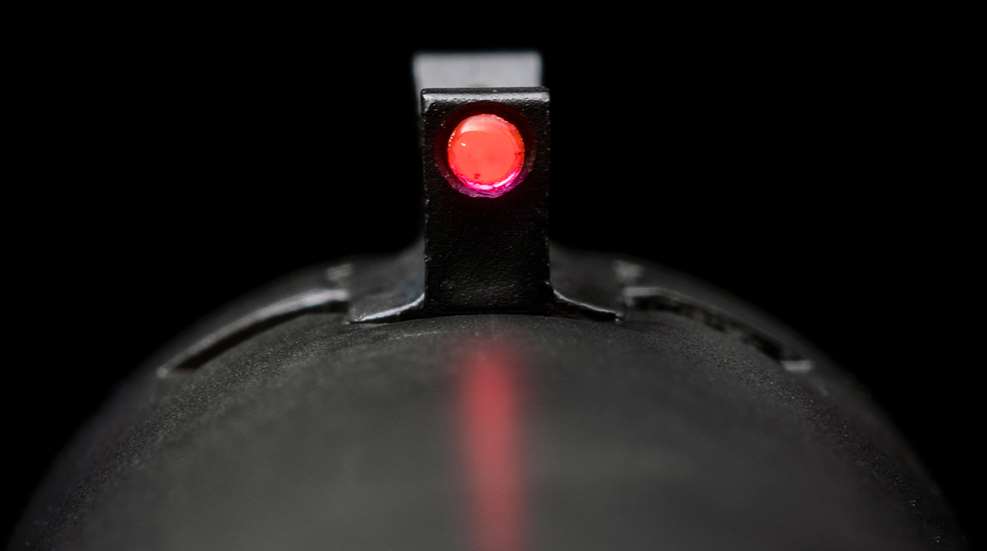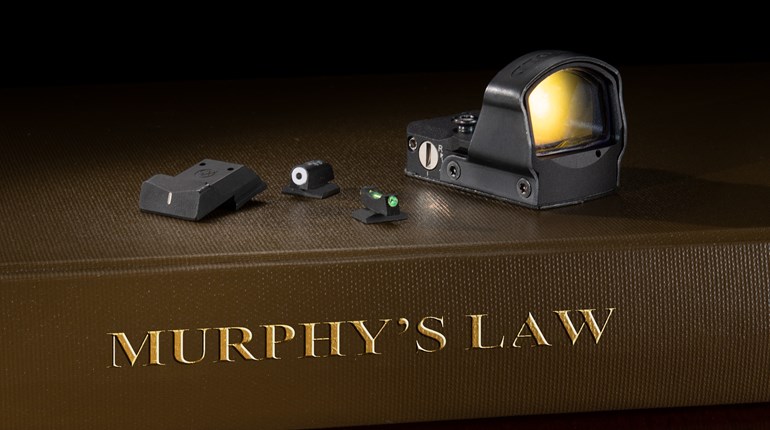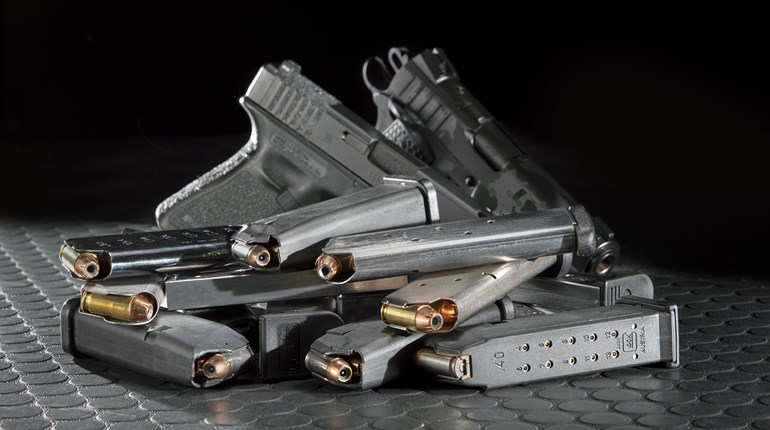
It’s one of the tiniest parts of a handgun, and yet it’s so vital that chanting it by name is a mantra for some shooters and a whole shooting school has adopted it as its name. I speak, of course, of the front sight.
Though it’s evolved from being so miniscule as to be useless in the early days, it remains a small piece of metal.
If your grip is solid and your sight picture adequate, you can make a complete soup sandwich of your trigger pull and the bullet will probably land pretty much where you intended, so it’s hard to overstate the importance of this little piece of metal. And yet it’s available in such an array of shapes and sizes and materials, it’s obvious that there’s no single correct setup for all needs. What gives?
If absolute accuracy were the only driving factor, a look at bullseye-type pistols would seem to indicate that a fairly narrow, plain-black sight will allow a precise aim on the target and, when coupled with a similarly narrow rear notch allowing the tiniest sliver of light on either side, will let the shooter know when there’s any deviation in the orientation of the handgun.
The thing is, in bullseye pistol shooting “rapid fire” equates to one shot every 2 seconds, so there’s plenty of time to line up what amounts to a very precise, if fairly fussy, sight picture.
In more “action-” or “combat-” type shooting sports, therefore, the fairly narrow front sight remains, but paired with a wider rear notch. This allows a bit more daylight around the front-sight blade, sacrificing a bit of precision for greater speed of acquisition. Plenty of people who are extremely competent shooters use this setup on carry guns, too, but their eyes are likely better than mine.
In poor light or against dark backgrounds, it can be easy to lose that plain, black front sight against the environmental clutter—or not pick it up rapidly enough in the first place—and now you’re back to index-shooting like you’re using an antique with hardly any sights at all.
One common remedy for this situation for competitive shooters and pistol-toters alike, is to retain the narrow, black front sight, but add a fiber-optic “light pipe” to it that will provide a bright dot in the middle of the sight blade. An earlier equivalent was a gold bead, shiny and untarnished.
This is quite effective, but not without its downsides. A fiber-optic light pipe will illuminate with very little ambient light, but it does need some ambient light— and from certain angles—to work properly. There are fiber-optic sights with built-in tritium lamps in case there isn’t enough ambient light, but these are bulkier and introduce problems of their own.
With plain, competition-type, fiber-optic sights, the fiber itself is a wear item. Put enough rounds through the pistol, and eventually you’ll need to replace the sights. I’ve had them last more than 5,000 rounds, and I’ve also had to replace them in as few as 2,000.
The other problem is that one can wind up focusing too hard on the fiber dot itself rather than the sight body in which it’s mounted. If you do this, you wind up lining the dot up with the upper edge of the rear notch, consequently shooting high.
That latter concern is common to any sort of attention-grabbing highlight on the front sight, which is why the “three-dot” arrangement is so common. The theory there is that the eye will want to line up the dot in the front sight between the two dots on the rear blade, avoiding the “too-high” problem that can develop with either a fiber dot or gold bead and a plain-black rear.
The classic three-dot arrangement can also sport three self-illuminating tritium vials, so even with less-than-ideal illumination, the shooter can properly align the sights. If you want to see how this is supposed to work, note the clever graphic design on the Trijicon logo. (This isn’t meant for shooting in a pitch-dark closet, but for situations of varying low-light conditions.)
The potential downside of sights like these is that they need to be a certain width to reliably accommodate a tritium vial. There’s the tendency to make them even a little wider to allow a boldly colored outline around the tritium so as to catch the eye during the day.
Said wide-front sights with their bold orange, green or white outlines are definitely fast to pick up in the eye line and make great coarse visual references, but the first time you use one to shoot a qualification course that involves having to score hits at 25 yards, you’ll see their downside. A B-8 bullseye or the “down zero” of an IDPA target will vanish behind a fat front sight at those distances.
TruGlo and now Trijicon have also combined technologies, using tritium with fiber optics to provide an onboard light source for the light pipe.
More than anything else on a pistol other than maybe grip shape and diameter, the front sight is an extremely personal choice. If I were to say “The Trijicon HD XR is the best front sight” it would make no more sense than saying “I think that Medium is the best size glove.”
You weighs your requirements, pays your money and takes your chances.





































